
Cotinis nitida, commonly known as the green June beetle, June bug or June beetle, is a beetle of the family Scarabaeidae. It is found in the eastern United States and Canada, where it is most abundant in the South. It is sometimes confused with the related southwestern species figeater beetle Cotinis mutabilis, which is less destructive.

Dyspteris is a genus of moths in the family Geometridae and was erected by Jacob Hübner in 1818. It is monotypic, being represented by a single species, Dyspteris abortivaria, commonly known as the bad-wing. This species was first described by Gottlieb August Wilhelm Herrich-Schäffer in 1855 and is found in North America.

Sphex ichneumoneus, known commonly as the great golden digger wasp or great golden sand digger is a wasp in the family Sphecidae. It is identified by the golden pubescence on its head and thorax, its reddish orange legs, and partly reddish orange body. This wasp is native to the Western Hemisphere, from Canada to South America, and provisions its young with various types of paralyzed Orthoptera.
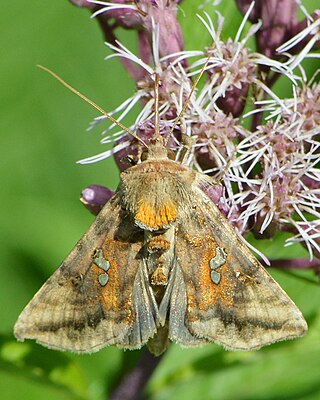
Autographa bimaculata, the two-spotted looper moth, twin gold spot or double-spotted spangle, is a moth of the family Noctuidae. The species was first described by James Francis Stephens in 1830. It is found in North America from Newfoundland west, just short of the coast of British Columbia, north to the Northwest Territories and south to New Mexico in the west and Pennsylvania and Long Island in the east.
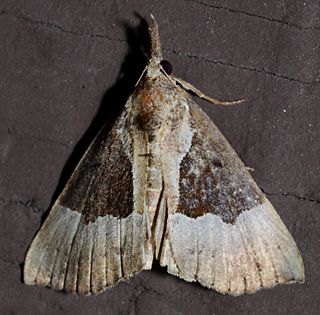
Hypena bijugalis, the dimorphic bomolocha, dimorphic hypena or toothed snout-moth, is a moth of the family Erebidae. The species was first described by Francis Walker in 1859. It is found in North America from Nova Scotia across southern Canada to Vancouver Island, south over the whole United States to Florida.
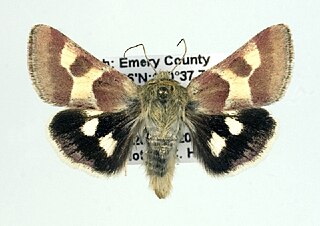
Schinia suetus is a moth of the family Noctuidae first described by Augustus Radcliffe Grote in 1873. It is widespread in the mountains of western North America, from southern Alberta west to British Columbia, south at least to Colorado and California, east to Idaho and New Mexico.

Lophocampa maculata, the Yellow-spotted tussock moth, mottled tiger or spotted halisidota, is a moth of the family Erebidae and the tribe Arctiini, the tiger moths. The species was first described by Thaddeus William Harris in 1841. It is found across Canada, the western parts of the United States, south in the Appalachians to South Carolina and Kentucky. They are also found in Southeastern Alaska.
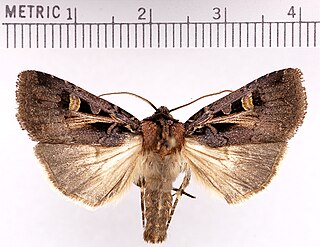
Feltia herilis, the herald dart or Master's dart, is a moth of the family Noctuidae. The species was first described by Augustus Radcliffe Grote in 1873. It is found in North America from Vancouver Island to Newfoundland, north to the Northwest Territories border and south to the Gulf Coast.
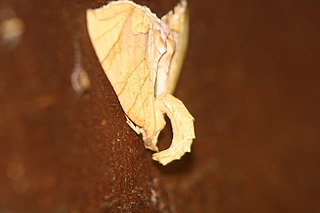
Eulithis gracilineata, the greater grapevine looper, is a moth of the family Geometridae. The species was first described by Achille Guenée in 1858. It is found from eastern Canada south to Florida. It has also been collected west to Saskatchewan and central Alberta, where it is rare.
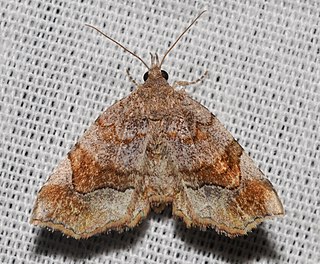
Pangrapta decoralis, the decorated owlet, is a moth in the family Erebidae. The species was first described by Jacob Hübner in 1818. It is found in North America from Alberta to Nova Scotia south to Florida and Texas.

Plagodis alcoolaria, the hollow-spotted plagodis, is a moth of the family Geometridae. The species was first described by Achille Guenée in 1857. It is found in eastern and central North America.

Oligocentria semirufescens, the red-washed prominent moth or rusty prominent, is a moth of the family Notodontidae. The species was first described by Francis Walker in 1865. It is found in North America from Nova Scotia west to Vancouver Island, south to Florida, Colorado and central California.

Eubaphe mendica, the beggar, is a moth of the family Geometridae. It was first described by Francis Walker in 1854 and it is found in eastern North America.
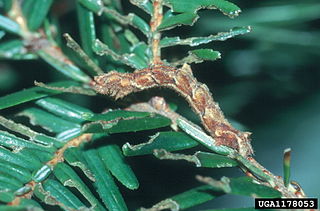
Nemoria mimosaria, the white-fringed emerald or flanged looper, is a moth of the family Geometridae. The species was first described by Achille Guenée in 1858. It is found from Nova Scotia to south-eastern Alberta, south to Virginia, Illinois, and Texas.

Apantesis virgo, the virgin tiger moth, is a moth of the family Erebidae. The species was first described by Carl Linnaeus in his 1758 10th edition of Systema Naturae. It is found in North America from Newfoundland south to Florida west to Alberta.

Cotinis is a genus of scarab beetles in the subfamily Cetoniinae found throughout North and South America. At least two species are common pests. The genus was erected by Hermann Burmeister in 1842.

Phaeoura quernaria, the oak beauty, is a moth of the family Geometridae. The species was first described by James Edward Smith in 1797. It is found in eastern North America, occurring as far west as east-central Alberta. The habitat consists of aspen-cherry shrubland.
Cotinis aliena is a species of Cotinis found in the Florida Keys.

The Gotini, who are generally equated to the Cotini in other sources, were a Gaulish tribe living during Roman times in the mountains approximately near the modern borders of the Czech Republic, Poland, and Slovakia.

Orchelimum pulchellum, the handsome meadow katydid, is a species of meadow katydid in the family Tettigoniidae. It is found in North America.



















